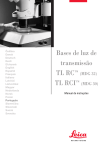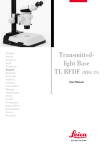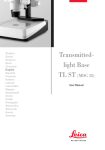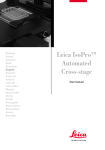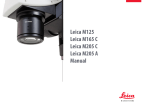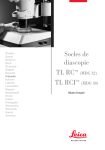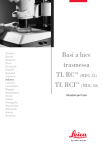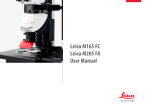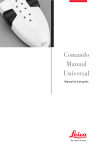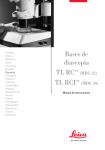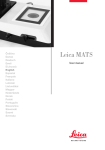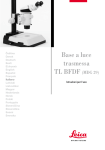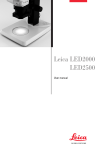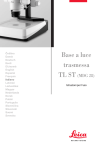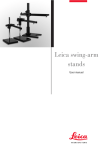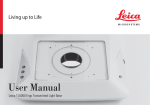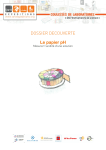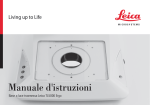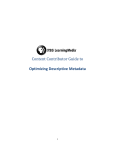Download Transmitted Light Bases TL RC™ TL RCI™
Transcript
Transmitted Light Bases TL RC™ (MDG 32) TL RCI™ (MDG 30) User Manual Contents Page Overviews Safety concept . . . . . . . . . . . . . . . . . . . . . . . . . . . . . . . . . . . . . . . . . . 4 Symbols . . . . . . . . . . . . . . . . . . . . . . . . . . . . . . . . . . . . . . . . . . . . . . . . 5 Safety regulations . . . . . . . . . . . . . . . . . . . . . . . . . . . . . . . . . . . . . . . .6 Controls . . . . . . . . . . . . . . . . . . . . . . . . . . . . . . . . . . . . . . . . . . . . . . . 8 Assembly . . . . . . . . . . . . . . . . . . . . . . . . . . . . . . . . . . . . . . . . . . . . . . 10 Operation Relief contrast . . . . . . . . . . . . . . . . . . . . . . . . . . . . . . . . . . . . . . . . . 12 Path-folding mirror . . . . . . . . . . . . . . . . . . . . . . . . . . . . . . . . . . . . . .12 IsoPro™ cross stage . . . . . . . . . . . . . . . . . . . . . . . . . . . . . . . . . . . .12 Light intensity and color temperature . . . . . . . . . . . . . . . . . . . . . .12 USB mouse . . . . . . . . . . . . . . . . . . . . . . . . . . . . . . . . . . . . . . . . . . . .13 Methods with transmitted light . . . . . . . . . . . . . . . . . . . . . . . . . . .14 Relief display . . . . . . . . . . . . . . . . . . . . . . . . . . . . . . . . . . . . . . . . . . .14 Filter . . . . . . . . . . . . . . . . . . . . . . . . . . . . . . . . . . . . . . . . . . . . . . . . . .16 Lamp replacement . . . . . . . . . . . . . . . . . . . . . . . . . . . . . . . . . . . . . .16 Care, maintenance . . . . . . . . . . . . . . . . . . . . . . . . . . . . . . . . . . . . . .17 Expansion diagram . . . . . . . . . . . . . . . . . . . . . . . . . . . . . . . . . . . . .18 Scope of delivery . . . . . . . . . . . . . . . . . . . . . . . . . . . . . . . . . . . . . . .19 Dimensioned drawing . . . . . . . . . . . . . . . . . . . . . . . . . . . . . . . . . . .20 Technical data . . . . . . . . . . . . . . . . . . . . . . . . . . . . . . . . . . . . . . . . . .22 2 Transmitted-light bases TL RC™ and TL RCI™ – Safety concept Dear User Thank you very much for your trust in Leica Microsystems. We hope your work with our high-quality, efficient products is both enjoyable and successful. In developing our instruments, we have placed great weight on simple, self-explanatory operation. However, take your time to read the user manual, in order to familiarize yourself with the optimal use of all the benefits and options of your stereo microscope. Should you have any questions, please consult your local Leica representative. You will find the address of the closest local representative as well as valuable information about products and services from Leica Microsystems on our homepage at www.leica-microsystems.com We are gladly at your service. CUSTOMER SERVICE is a big thing with us. Not only before the sale, but afterwards as well. Leica Microsystems (Switzerland) Ltd. Stereo & Macroscope Systems www.stereomicroscopy.com The user manual This user manual is available in 20 additional languages on our interactive CD-ROM. User manuals and updates are also available for download on our homepage at www.stereomicroscopy.com. The user manual at hand describes the safety instructions, assembly, and handling of the TL RC™ and TL RCI™ transmitted-light bases. Transmitted-light bases TL RC™ and TL RCI™ – Safety concept 3 Safety concept 1.1 The user manual The TL RC™ /TL RCI™ transmitted-light bases come with an interactive CD-ROM containing all relevant manuals in 20 additional languages. Keep this CD-ROM in a safe place, where it is available to the user. User manuals and updates are also available for download and print-out on our homepage at www.stereomicroscopy.com. Before assembly, start up and use, please read the user manuals cited above. In particular, please observe all safety instructions. To maintain the unit in its original condition and to ensure safe operation, the user must follow the instructions and warnings contained in these user manuals. The TL RC™ and TL RCI™ transmitted-light bases are a module of the Leica M stereo microscope series. This user manual describes the special functions of the transmitted-light base and contains important instructions for operating safety, maintenance and the accessory parts. The M2-105-0 user manual for the Leica M stereo microscopes contains additional safety rules for the stereo microscope, accessories and electrical accessories, as well as instructions for maintenance. You can combine the transmitted-light base TL RC™ with any cold light source and a glass fiber light guide (active f = 10mm, tail tube f = 13mm). Please read the user manual and the safety requirements of the supplier. 4 Transmitted-light bases TL RC™ and TL RCI™ – Safety concept 1.1.1 Symbols used Warning of danger This symbol indicates information, which must be read and obeyed. Disregarding these instructions – can cause hazards to personnel! – can lead to functional disturbances and damaged instruments. Important information This symbol indicates additional information or explanations that intend to provide clarity. Action 왘 This symbol within the text indicates that certain operations must be carried out. Warning of dangerous electrical voltage This symbol indicates especially important information, which must be read and obeyed Disregarding these instructions can lead to – can cause hazards to personnel! – can lead to functional disturbances and damaged instruments. Explanatory notes • This symbol indicates additional notes and explanations provided in the text. Figures (1.5) Numbers in brackets within the descriptions relate to the figures and the items within those figures. Example (1.3): Figure 1 is located, for example, on Page 8 and item 3 is the filter carrier. Warning - hot surface This symbol warns you of tangible, hot points, such as light bulbs. Transmitted-light bases TL RC™ and TL RCI™ – Safety concept 5 1.2 Safety regulations Description The transmitted-light bases TL RC™ and TL RCI™ fulfill the highest requirements for observation and documentation of Leica stereo microscopes of the M series. It contains a path-folding mirror, a device for partial pupil illumination and relief contrast generation, a ground-glass screen, an additional condenser and Fresnel lenses. The complete stand consists of: – Transmitted-light base TL RC™ or TL RCI™ – Stand 300 mm or 500 mm long with focusing drive, manual coarse/fine or motorized focus – Glass stage plate, clear, 220×170×4mm – Light source and light guide according to requirements Accessories: – Gliding stage – Leica MATS Thermocontrol System with heating stage – Polarization set and many more (see Expansion diagram) Intended uses TL RC™ and TL RCI™ transmitted-light bases are used in the assembly of Leica M series stereo microscopes via tripod column and microscope carrier. They can be combined with any cold light source and light guide and allows you to observe transparent specimen with relief contrast and direct transmitted light. The TL RCI™ transmittedlight base posseses an integrated halogen lamp that particularly supports control by Leica Application Suite (LAS) software. Never: – Change, rebuild or take apart parts, if not specifically instructed to in this manual. – Let non-authorized persons open parts of the instrument. – Use the transmitted-light base TL RC™/TL RCI™ for investigations and operations on the human eye. The units or accessory components described in the user manual have been checked for safety and possible dangers. Always consult the responsible Leica office or the main plant in Wetzlar at any time there is a need to adjust the unit or it is combined with non Leica components which go beyond the scope of this manual. Unauthorized adjustment of the unit or improper use renders the warranty null and void. Place of use – Only use the transmitted-light base TL RC™/ TL RCI™ in closed, dust free rooms and between +10°C and +40°C. Make sure that the rooms are free of oil vapors or other chemical vapors and extreme humidity. – Set up the electrical components at least 10 cm from walls and combustible objects. – Avoid large temperature fluctuations, direct sunlight and vibrations. This can cause faulty measurements or microphotographs. – In warm, or warm and humid climatic zones, the transmitted-light base TL RC™/ TL RCI™ requires particular care to prevent formation of fungus. Prohibited uses If you use the transmitted-light base TL RC™/TL RCI™, its components, and the accessories in a way other than that described in the user manual, harm may be caused to people or objects. 6 Transmitted-light bases TL RC™ and TL RCI™ – Safety concept Responsibilities of person in charge of the instrument Ensure that – The transmitted-light base TL RC™/ TL RCI™ and the accessories are only operated, maintained and repaired by authorized and trained personnel. – Personnel who use the instrument have read and understood this user manual and in particular the safety instructions and obey them. Repairs, servicing work – Repairs may only be carried out by servicing engineers trained by Leica Microsystems or your own authorized technical personnel. – Only original Leica Microsystems parts may be used. – Before opening the devices, turn off power and unplug mains cables. If you touch the electric circuit of the equipment, you may receive an electric shock. Integration in third-party products The following must be observed if Leica products are built into third-party products: The manufacturer of the complete system or the person putting it on the market is responsible for adhering to applicable safety regulations, laws and guidelines. Disposal The products described here must be disposed off in accordance with applicable local laws and regulations. Legal requirements Adhere to general and local regulations relating to accident prevention and environmental protection. EU declaration of conformity The transmitted-light base TL RC™/ TL RCI™ and the accessories have been constructed according to the state of the art and issued with an EU declaration of conformity. Transport – Use the original packaging for shipping or transporting the transmitted-light base TL RC™/ TL RCI™ and the accessory components. – To prevent damage through vibrations, remove and pack specially all the moving components which you installed yourself, in accordance with the user manual. Transmitted-light bases TL RC™ and TL RCI™ – Safety concept 7 Controls 1 2 3 4 5 6 7 Fig. 1 1 2 3 4 5 6 7 8 Cooling element of integrated halogen illumination (TL RCI™ only) Adapter plate for easy assembly of focusing drives Standard stage 10 447 269 Filter bracket for up to three filters Control button for the upper and lower Rottermann-Contrasts™ flap Button to rotate and side-to-side movement of mirror TL RCI™ transmitted-light base Transmitted-light bases TLRC™ and TL RCI™ Fig. 2 Adapter plate vertical pole - transmitted-light base 1 3 4 5 2 6 Fig. 4 Back side of transmitted-light base TL RCI™ 1 2 3 4 5 6 Fig. 3 Adapter between focusing drive and microscope carrier Fig. 5 USB mouse for TL RCI™ control Power switch Power socket USB socket Type B USB socket Type A 2× Can-Bus Screws for halogen lamp replacement Transmitted-light bases TLRC™ and TL RCI™ 9 Assembly 3.2.2 IsoPro™ cross-stage Before unpacking, make sure no person can get injured by falling or tilting part. 3.1 Unpacking the base The base is delivered with the adapter plate attached. The selected stage (IsoPro™ crossstage or standard stage 10 447 269), and the focusing drive will have to be mounted later. Make sure the devices are unpacked on a flat, sufficiently dimensioned, and non-slip surface. Before the IsoPro™ cross-stage is mounted to the base, the axis containing the control buttons is attached optionally on the left or the right side of the cross-stage. If the controls shall be mounted on the left side, the gear rod on the bottom side of the cross-stage must be unscrewed and re-attached in reverse. 왘 Take the glass plate from the cross-stage. 왘 Turn the cross-stage around and place it onto a non-slip surface. 왘 Change the gear rod (6.2) from the left to the right side. 왘 Skip the next two steps to mount the controls. 3.2 Stage assembly The TL RC™/ RCI™ transmitted-light base can be equipped with two different stages. The selected stage is mounted on the base before start-up. The two stages can be easily exchanged at any time. Control assembly The following paragraph assumes the base without the stage mounted. Disassembly is performed in reverse order of the following steps. 왘 Attach the axis with the control buttons (6.1) to 3.2.1 Standard stage 왘 Take the glass plate from the rectangular gap in the standard stage. 왘 Position the stage on the transmitted-light base in such way that the four holes align over those in the base. 왘 Attach the stage to the base with the four supplied Allen screws. 왘 Insert the glass plate back into the standard stage. 10 왘 Take the glass plate from the cross-stage. 왘 Turn the cross-stage around and place it onto a non-slip surface. the desired side. The fastener snaps into the cross-stage magnetically. 왘 Attach the axis with the two supplied Allen screws. 왘 Attach the cover rail to the cross-stage. Cross-stage assembly 왘 Place the cross-stage onto the base. 왘 Pull the upper part of the cross-stage carefully toward the user, fixing the lower part onto the transmitted-light base. 왘 Attach the cross-stage evenly to the three threaded holes. 왘 Push the cross-stage all the way back to the fence in direction of the column. 왘 Re-insert the glass plate back into the standard stage. TL RC™ and TL RCI™ transmitted-light bases – Assembly 3.3 Focusing drive column 왘 Unscrew the adapter plate (1.2) from the base using the supplied Allen key. 왘 Attach your focusing drive column to the bottom with the three Allen screws (2). 왘 Re-attach the adapter plate to its original 1 position. 2 3.4 Intermediate adapter assembly Mount the supplied adapter between the column and microscope carrier, to balance the enlarged distance between focusing drive and optical axis. 왘 Attach the adapter (3) to the focusing drive for the pins to lock in recess. 왘 Attach the adapter using the supplied Allen key. Fig 6 Rear side of the IsoPro™ cross-stage 1 Axis with controls 2 Gear rod, mounted to cross-stage 3.5 Equipment assembly After mounting the adapter to the focusing drive, the microscope carrier, optics carrier, and the entire equipment can be assembled as usual. 3.6 Connecting the cold light-source to the TL RC™ base 왘 Push the appropriate end of the cold light guide into the base back-side. 왘 For further information about the use of cold light sources refer to the instructions supplied separately. 3.7 Connecting the power cable (TL RCI™) 1 2 Fig. 7 Cross-stage controls 1 Control button for x-direction movement 2 Control button for y-direction movement 왘 Make sure the power switch (4.1) on the base is turned to „O“. 왘 Insert the power cable into the mains socket (4.2), and then connect it to a grounded outlet. TL RC™ and TL RCI™ transmitted-light bases – Configuration 11 Operation 4.1 Switch for adjusting the relief contrast Use the two switches (8.1 and 8.2) on the left side of the transmitted-light base TL RC™/TL RCI™ to actuate the two integrated flaps. The outer switch (8.1) controls the inverted relief contrast. The inner switch (8.2) controls the positive relief contrast. Depending on the flap position, part of the opening of the integrated Fresnel lens is covered causing different contrast effects. Phase structures typically appear as spatial, relief images – like hills in a positive relief contrast and as recesses in inverted relief contrast. The contrast can be increased without relief by adjusting the two diaphragms to 45°. A slot shaped illuminated area appears. The slot can be moved over the entire field of view and quickly switched between positive and negative relief view by precise tilting of the path-folding mirror. The dynamic effect makes it simple to distinguish phase structures from amplitude structures. Depending on the properties of the object (refractive index to environment) and your own sensitivity, it may occur that you need to operate the switches for the positive and inverted relief contrast in reverse. These switches are described below. I.e. instead of the top switch (8.1), the bottom switch (8.2) controls the inverted relief contrast. Instead of the bottom switch (8.2), the top switch (8.1) controls the positive relief contrast. 4.2 Path-folding mirror The built-in path-folding mirror features a flat and a concave side and can be rotated and moved. The concave side was specifically designed for the optical features of objectives with high 12 numeric aperture. Using the black rotary knob (8.1) on the left side of the transmitted light base you can turn and push the path-folding mirror back and forth. The concave recess at the grip shows the concave side of the mirror and allows the intuitive operation without eye contact at anytime. Depending on the angle and position of the mirror the angle of light incidence changes on the specimen level so that you can move between a transmitted light bright field, through oblique illumination to dark field like illumination. The black rotary knob (8.1) on the left side of the transmitted-light base is used: – To rotate the path-folding mirror from the flat to the concave side – For slight tilting, to steer the light beam more steeply or flatly through the object level – To shift the path-folding mirror (forward/ backward) 4.3 Operating the cross-stage IsoPro™ 왘 To move the stage in X direction rotate the outer knob (7.1) 왘 To move the stage in Y direction rotate the inner ring around the knob (7.2) 4.4 Light intensity and color temperature 4.4.1 Transmitted-light base TL RC™ Please observe the user manual and in particular the safety regulations of the manufacturers of the light guide and cold light source. 왘 Turn on the cold light source according to the manufacturer's user manual and connect, activate, and adjust the light intensity. TL RC™ and TL RCI™ transmitted-light bases – Operation 1 2 3 1 2 Fig. 8 Fig. 8 1 Switch to control the inverted relief contrast 2 Switch to control the positive relief contrast 3 Path-folding mirror 1 Potentiometer Control of IsoCol™ illumination intensity 2 Potentiometer Control of dye temperature 4.4.2 TL RCI™ transmitted-light base 4.5 Leica USB mouse (TL RCI™ only) The TL RCI™ transmitted-light base has two electronic potentiometers to control the dye intensity (9.1), and dye temperature (9.2) separately. The Leica USB mouse controls the IsoCol™ and the dimming function of the TL RCI™ base . 왘 Adjust the dye intensity using the front poten- tiometer (9.1) to match your requirements. 왘 With the rear potentiometer (9.2), set the dye temperature to match the color impression to your requirements. The dye temperature control also serves as electronic shutter: 왘 For process interruption, press the potentiometer (9.2). 왘 To switch on the illumination, press the potentiometer again. The electronics return to the previously selected settings. 왘 Connect the mouse (5) to the appropriate USB port of the base (4.4). • By default, the scroll wheel of the mouse is assigned to the IsoCol™ control. 왘 Scroll away from the user to increase the illumination intensity in IsoCol™ mode. 왘 Scroll towards the user to decrease the illumination intensity in IsoCol™ mode. 왘 Click the scroll wheel briefly to switch the illumination on or off. 왘 To switch between the IsoCol™- and dimming mode and back, click on and hold the scroll wheel for more than 2 seconds. • The intensity in the dimming mode changes analog to the IsoCol™ mode. TL RC™ and TL RCI™ transmitted-light bases – Operation 13 4.6 Methods with transmitted light 4.6.1 Vertical bright field illumination Suitable for colored amplitude preparations with sufficient contrast. The flatter the light rays are deflected into the objects the darker the background appears. A transmitted light similar to a dark field is created. Contours, fine edges and structures are brightly emphasized by diffraction of the light on the dark background. 왘 Both switches should be placed in horizontal position. • The flaps are open. 왘 Using the black rotary knob (8.3) on the lefthand side of the transmitted-light base, shift the path-folding mirror towards the column until it hits the stop. 왘 According to the aperture of the used objective rotate either the plane or concave side of the path-folding mirror toward the top. 왘 Turn the path-folding mirror to the notch position at 45°. 4.6 Relief display The light beams are steered vertically through the object. The outcome of this is an exact bright field with maximum brightness. 4.6.1 Positive relief contrast 4.6.2 Inclined transmitted light Suitable for semitransparent, opaque objects such as foraminiferes and fish eggs. 왘 Both switches should be placed in horizontal position. • The flaps are open. 왘 Turn the path-folding mirror (8.3) so that the light beams fall through the object diagonally. 왘 Shift the path-folding mirror until the required information is visible. 4..3 Asymmetrical dark-field illumination 왘 Both switches should be placed in horizontal position. • The flaps are open. 왘 Rotate the path-folding mirror (8.3) so that the light beams pass flatly through the object. 14 Starting position 왘 Using the black rotary knob (8.3) on the righthand side of the transmitted-light base, shift the path-folding mirror towards the column until it hits the stop. 왘 Turn the path-folding mirror to the notch position at 45°. 왘 Both switches should be placed in horizontal position. • The flaps are open. 왘 Rotate the inner switch (8.2) close to the upright position. • The bottom flap is closed. There is positive relief contrast. The phase structures act like hills. 왘 Intensify or weaken the effect by tilting the path-folding mirror. 4.6.2 Negative relief contrast 왘 Rotate the inner switch (8.2) close to the horizontal position. • The bottom flap is open. 왘 Rotate the upper switch (8.1) close to the upright position. • The top flap is closed. There is negative relief contrast. Phase structures appear as recesses. 왘 Intensify or weaken the effect by tilting the path-folding mirror (8.3). TL RC™ and TL RCI™ transmitted-light bases – Operation 4.6.3 Dynamic relief contrast 4.6.4 Limitations 왘 Place both switches in about a 45° degree The relief methods give good results from medium zoom up to a high level of magnification and with the 1×, 1.6× and 2× objectives. In the bottom half of the zoom scale and with weaker objects, it may occur that the object field is not homogeneously lit. We recommend using the transmitted-light base with objectives of 1× and higher and not with objectives with long focal distances. position. • The flaps are set to 45°. A slot shaped illuminated area appears. The slot can be moved over the entire field of view and can be quickly switched between positive and negative relief view by precise tilting of the path-folding mirror (8.3). The dynamic effect makes it simple to distinguish phase structures from amplitude structures. 1 2 3 4 5 6 7 8 Fig. 10 Switch positions to control the transmitted light 1 Switch position with transmitted light: Both flaps are open 2 Switch position with positive relief contrast, medium 3 Switch position with positive relief contrast, strong 4 Switch position with inverted relief contrast, medium 5 Switch position with inverted relief contrast, strong 6 Switch position with increased contrast without relief contrast 7 Switch position with increased contrast without relief contrast, path-folding mirror tilted 8 Switch position with increased contrast without relief contrast, path-folding mirror tilted TL RC™ and TL RCI™ transmitted-light bases – Operation 15 4.7 Filter TL RC™ and TL RCI™ transmitted-light bases can be equipped with up to three filters simultaneously, that are available as accessory (see Expansion Diagram page 18/19). The individual filters are also available to customers upon special request. 왘 Turn off the light source or press (TL RCI™) the switch for the shutter (9.2). 왘 Retrieve the empty filter from an available filter location at the filter holder. 왘 Insert the desired filter. 왘 Activate the light source again. 4.8 Changing the halogen lamp (TL RCI™) It is absolutely necessary that you unplug the power cord form the base before changing the lamp in order to prevent possible electrical shock! 3 The halogen lamp is getting very hot during operation. Keep the base turned off for about 10 minutes to allow for cooling and in order to prevent burns! 왘 Loosen the two bolts at the cooling element (11.1). 왘 Carefully pull out the entire cooling element, including the lamp. 왘 Remove the lamp holder (11.2) by pulling it from the guide rail. 왘 Carefully pull off the lamp including its socket 1 Fig. 11 TL RCI™ transmitted-light base open lamp housing 1 Screws for loosening the cooling fins 2 Lamp holder 3 Halogen lamp 12V/20W from the holder. 왘 Remove the lamp (11.3) out of the socket. Never touch the new halogen lamp with bare fingers since this will significantly reduce the life expectancy of the lamp! 왘 Push the new lamp into the socket. 왘 Perform all above identified steps in reverse order. 16 2 TL RC™ and TL RCI™ transmitted-light bases – Operation Care, maintenance In this chapter we would like to explain and help you understand the careful handling of your valuable instrument, and provide you with some tips for proper maintenance and cleaning. We guarantee the quality You are using a precision instrument with many performance features. As appropriate for such instruments we guarantee the quality of our products. This guarantee covers all manufacturing and material defects of the original equipment, but not any damages that are the result of inappropriate use or negligence. Please handle your valuable optical instrument with appropriate care. If you do so you will be able to enjoy many decades of accurate service by this equipment without any deterioration. This is the reputation of our equipment. Should your equipment, however, no longer provide accurate service, please contact your authorized service representative, your Leica distributor or directly Leica Microsystems (Switzerland) Ltd., CH-9435 Heerbrugg. Protect your instruments • Protect from moisture, fumes, acids, bases and corrosive materials. Do not store any chemicals in close proximity of the instrument. • Protect from inappropriate use or handling. Never use off-brand electrical connectors or wires; never disassemble optical systems or mechanical components, if no particular reference is made to that purpose in the instructions. • Protect from oil and grease. Slide surfaces and mechanical components shall never be lubricated. TL RC™ and TL RCI™ transmitted-light bases – Care, Maintenance 17 Expansion diagram 10 445 615 (300mm) 10 446 100 (500mm) 10 447 392 11 101 784 10 447 391 10 446 303 10 447 276 10 447 106 (300mm) 10 447 185 (500mm) 10 446 304 10 447 275 10 446 228 10 446 301 10 447 269 10 446 176 (300mm) 10 447 041 (500mm) 10 446 353 10 446 302 10 382 130 10 361 719 10 447 368 10 446 352 10 447 390 10 446 351 10 446 350 10 447 393 10 447 394 10 447 395 10 447 342 10 446 340 10 447 400 10 446 341 10 447 398 10 447 431 18 TL RC™ and TL RCI™ transmitted-light bases – Expansion diagram 4 / 11.05 10 447 443 Scope of delivery 10 446 340 10 446 341 10 447 342 10 446 350 10 446 351 10 447 390 10 446 352 10 447 269 10 446 353 10 447 368 10 447 275 10 447 276 10 447 391 10 447 392 11 101 784 Incident-light bases Incident-light base for S series Transmitted-light sub-base for incident-light base S series Incident-light base for M series Transmitted-light base TL ST Transmitted-light base TL BFDF Transmitted-light base TL RC™ for external cold light sources TL RCI™ transmitted-light base with integrated halogen illumination Stages Standard stage for transmitted-light bases TL BFDF, TL RC™ and TL RCI™ Cross-stage for transmitted-light bases TL BFDF, TL RC™, TL RCI™ and incident-light base (with adapter 10 447 368) Adapter between cross-stage and incident-light base 10 447 342 Thermo stage Leica MATS TL with controller Adapter for stages with ∅120mm Stage for LifeOnStage accessory Universal carrier for Petri inserts, object carriers (up to four pieces) etc. 10 445 615 10 446 100 10 447 106 10 447 185 10 446 176 10 447 041 10 447 400 10 447 394 10 447 395 10 447 393 Column adapter for micromanipulation 10 447 443 10 446 301 10 446 302 10 382 130 10 361 719 10 446 303 10 446 304 10 446 228 Sliding stage, ∅120mm Polarization stage, ∅120mm Objective guide for polarization stage Compensator Red I for Pol rotating stage Cup stage, ∅120mm Universal carrier, ∅120mm Glass insert with Pol, ∅120mm 10 443 401 10 447 398 10 447 431 Focusing drive Focusing drive with 300mm profile column for incident and transmittedlight bases Focusing drive with 500mm profile column for incident and transmittedlight bases Focusing drive, fast/fine, with 300mm profile column for incident and transmitted-light bases Focusing drive, fast/fine, with 500mm profile column for incident and transmitted-light bases Motorized focus drive with 300mm column and power adaptor for incident and transmitted-light bases Motorized focus drive with 500mm column and power adapter for incident and transmitted-light bases Filter Day light filter for basis TL ST BG38 Fluorescent filter for transmitted-light bases TL RC™/ RCI™ UV filter for bases TL RC™/ RCI™ Filter ND (gray filter) for bases TL RC™/ RCI™ Illumination Leica USB mouse, freely assignable five key mouse for connecting to transmitted-light bases TL RCI™ or PC USB cable to connect TL RCI™ basis to a PC Foot switch with CAN bus connector Ergo accessories Leica ErgoRest (palm rest to prevent tiresome work environment) TL RC™ and TL RCI™ transmitted-light bases – Scope of delivery 19 Measurements transmitted-light base TL RC™ Dimensions in mm 497 370 154 95 116 95 187 95 154 154 340 X= +-75mm 370 Transmitted-light base TL RC™ with standard stage 10 447 269 20 Transmitted-light base TL RC™ with IsoPro™ cross-stage Transmitted-light bases TL RC™ and TL RCI™ – Technical data 300 249 Y= +-50mm 390 max. 370 Measurements TL RCI™ transmitted-light base Dimensions in mm 497 385 154 187 154 95 95 116 154 300 249 Y= +-50mm 440 390 max. 410 340 X= +-75mm 370 TL RCI™ transmitted-light base with standard stage 10 447 269 TL RCI™ transmitted-light base with IsoPro™ cross-stage Transmitted-light bases TL RC™ and TL RCI™ – Technical data 21 Technical data Light source Fast exchange of illuminant Illuminated area Power Connector Connectors Weight Illumination types Bright field Dark field Oblique light Relief contrast system (RC™) CCIC (Constant Color Intensity Control) Internal shutter/Lamp control Integrated filter holder Coated optic to raise color temperature Matching of high num. aperture Remote control possibility AntiShock™ Pads Size of the base (W×H×D, in mm) Leica TL RC™ external via cold light source – 35mm – – – – Connection for cold light guide active f=10mm End pipe f=13mm 6.0 kg Leica TL RCI™ Halogen lamp 12V/20W yes 35mm Input Voltage 100 – 240 V~ Frequency 50 – 60 Hz Energy consumption 30 W max. Ambient temperature 10 – 40 °C 1×USB Type A, 1×USB Type B 2×CAN-BUS yes yes* yes yes no yes yes* yes yes yes yes** yes yes yes yes yes yes*** yes**** yes 340×390×95 yes*** yes yes 340×440×95 7.2 kg * single sided **with cold light source Leica CLS150 LS ***concave mirror **** with external light source 22 Leica M stereomicroscopes User Manual Leica M stereomicroscopes User Manual 23 Leica Microsystems – the brand for outstanding products Leica, the leading brand for microscopes and scientific instruments, developed from five brand names, all with a long tradition: Wild, Leitz, Reichert, Jung and Cambridge Instruments. Yet Leica symbolizes innovation as well as tradition. Leica Microsystems – an international company with a strong network of customer services Australia: Austria: Canada: China: Denmark: France: Gladesville, NSW Vienna Richmond Hill/Ontario Hong Kong Herlev Rueil-Malmaison Cédex Bensheim Milan Tokyo Seoul Rijswijk Lisbon Germany: Italy: Japan: Korea: Netherlands: Portugal: Singapore: Spain: Barcelona Sweden: Sollentuna Switzerland: Glattbrugg United Kingdom: Milton Keynes USA: Bannockburn/Illinois Tel. Tel. Tel. Tel. Tel. +1 800 625 286 +43 1 486 80 50 0 +1 905 762 20 00 +8522 564 6699 +45 44 5401 01 Fax Fax Fax Fax Fax +61 2 9817 8358 +43 1 486 80 50 30 +1 905 762 89 37 +8522 564 4163 +45 44 5401 11 Tel. Tel. Tel. Tel. Tel. Tel. Tel. Tel. Tel. Tel. Tel. Tel. Tel. +33 1 4732 8585 +49 6251 1360 +39 02 57 486 1 +81 3 543 596 09 +82 2 514 6543 +31 70 41 32 130 +35 1 213 814 766 +65 6 77 97 823 +34 93 494 9530 +46 8 625 45 45 +41 44 809 34 34 +44 1908 246 246 +1 800 248 0123 Fax Fax Fax Fax Fax Fax Fax Fax Fax Fax Fax Fax Fax +33 1 4732 8586 +49 6251 136 155 +39 02 5740 3273 +81 3 543 596 15 +82 2 514 6548 +31 70 41 32 109 +35 1 213 854 668 +65 6 77 30 628 +34 93 494 9532 +46 8 625 45 10 +41 44 809 34 44 +44 1908 609 992 +1 847 405 0164 and representatives of Leica Microsystems in more than 100 countries. In accordance with the ISO 9001 certificate, Leica Microsystems (Switzerland) Ltd, Business Unit Stereo & Macroscope Systems has at its disposal a management system that meets the requirements of the international standard for quality management. In addition, production meets the requirements of the international standard ISO 14001 for environmental management. Leica Microsystems (Switzerland) Ltd Stereo & Macroscope Systems CH-9435 Heerbrugg Telephone +41 71 726 33 33 Fax +41 71 726 33 99 www.leica-microsystems.com www.stereomicroscopy.com The companies of the Leica Microsystems Group operate internationally in four business segments, where we rank with the market leaders. ● Microscopy Systems Our expertise in microscopy is the basis for all our solutions for visualization, measurement and analysis of microstructures in life sciences and industry. With confocal laser technology and image analysis systems, we provide threedimensional viewing facilities and offer new solutions for cytogenetics, pathology and materials sciences. ● Specimen Preparation We provide comprehensive systems and services for clinical histo- and cytopathology applications, biomedical research and industrial quality assurance. Our product range includes instruments, systems and consumables for tissue infiltration and embedding, microtomes and cryostats as well as automated stainers and coverslippers. ● Medical Equipment Innovative technologies in our surgical microscopes offer new therapeutic approaches in microsurgery. ● Semiconductor Equipment Our automated, leading-edge measurement and inspection systems and our E-beam lithography systems make us the first choice supplier for semiconductor manufacturers all over the world. Illustrations, descriptions and technical data are not binding and may be changed without notice. M2-218-2en • © Leica Microsystems (Switzerland) Ltd • CH-9435 Heerbrugg, 2005 • Printed in Switzerland – en – XII.2005 – RDV Leica Microsystems’ mission is to be the world’s first-choice provider of innovative solutions to our customers’ needs for vision, measurement, lithography and analysis of microstructures.
























